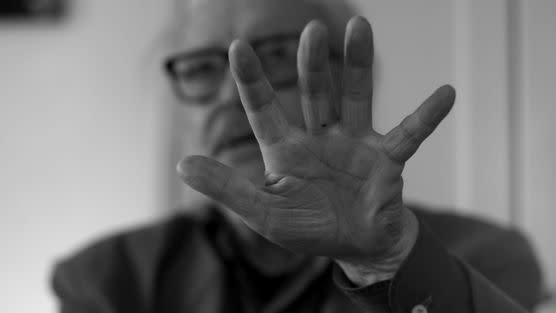‘Scénarios’ Review: Cannes Premieres a Short Completed by Jean-Luc Godard the Day Before His Death, and Also a Film About the Making of It
- Oops!Something went wrong.Please try again later.

A year ago, the Cannes Film Festival presented the world premiere of what was widely taken to be Jean-Luc Godard’s final film. He had died by assisted suicide eight months before, and the 20-minute-long “Trailer of the Film That Will Never Exist: ‘Phony Wars'” felt, by nature, like the aestheticized version of a last will and testament. It was a collage film, and it was (surprise!) oblique, yet it offered tea leaves to read about Godard’s state of mind as he prepared to leave the world.
As it turns out, “Trailer of the Film…” was not Godard’s final work. The 18-minute-long “Scénarios,” also made in a collage style, but simpler and more direct, was unveiled today at Cannes, along with a 34-minute documentary about the making of the short. “Scénarios” has the feel of a minor but purefied late-period work, like a Matisse paper cutout. What’s fascinating about it is that this one is explicitly offered as a summing-up statement from Godard to the world. He completed work on “Scénarios” the day before he died, and watching the film now is like seeing a message from the beyond.
More from Variety
Jacob Elordi Skips Cannes as Crying Paul Schrader Accepts 4-Minute Standing Ovation for 'Oh, Canada'
The film grows out of the formal experimentation that Godard brought to fruition in “The Image Book” (2018); it’s a swirl of images and visions. Some are beautiful, like the self-portrait that Godard looks like he created with colorful squiggles from my daughter’s phone-app easel. Some are dips into film history. But the movie is ultimately about two things: death and war. Like most Godard films, it’s both a personal and a social-political statement, and you can’t separate the two.
On the personal front, Godard wants to look death in the face, and does so with telling clips from “Band of Outsiders,” “Contempt,” and film noir. But the war stuff is even more haunting. Early on, we hear the words “A final warning” and are confronted with the grainy color photograph of a soldier in a helmet, his body submerged in water as he holds a rifle aloft. Godard lets us stare at that shot just long enough for it to become iconic in our minds. “Scénarios” contains other images of war (a closeup of a knight’s iron visor, a still from “Ivan the Terrible”), as if Godard were telling us to prepare for the war that’s coming.
Then again, one should never be too literal about the meaning of a Godard film. In the last two minutes of “Scénarios,” Godard is suddenly there on camera, sitting on his cot in an unbuttoned shirt, his old man’s pot belly exposed, as he looks down and reads an aphorism from Jean-Paul Sartre. It’s a version of a thought we heard earlier in the film: “Using a horse to illustrate that a horse is not a horse is less efficient than using a non-horse to illustrate that a horse is not a horse.”
I took that to mean that for Godard, a horse is not a horse because in this world, nothing is what it seems. That idea undergirds so many of Godard’s obsessions (cinema, advertising, socialism, machines, the Holocaust). It’s what makes everything his movies touched a mystery. Then, for just a flash, he raises his head and peers into the camera; his large eyes, intense as ever, pierce the screen and seem to look right at us. Then he says “Okay,” as the screen cuts to black. He’s done. That “okay” is his acceptance of passing into the next world.
“Scénarios” was shown — and will presumably be paired in select art houses — with “The Film Preview of “Scénarios,'” which captures Godard in the act of creating the film. That means that for 34 minutes, he takes us through the orderly small-scale script he’s assembled on a scrapbook of cream-colored Canon pasteboard. Godard’s visible age (he died at 92) is part of the effect; he sits there in a sweater, glasses perched on his head, and we behold his wispy gray longish hair, his age spots, his voice of delicate gravel.
Describing the pages of a scrapbook may not look like “filmmaking.” And, in fact, Godard is giving directions to his collaborators, notably Fabrice Aragno, the Swiss filmmaker and photographer who’s been his close associate since 2002. But what we see, in this rare and final glimpse of Godard at work, is the meditation of his method. He plans out and explains what he does with the care of a medieval stone cutter. He places one thing next to another with such deliberation that he creates something deceptively bigger than both of them: a meaning that’s a detonation. Right to the end, he wanted to blow up everything we thought we knew.
Best of Variety
Sign up for Variety’s Newsletter. For the latest news, follow us on Facebook, Twitter, and Instagram.
